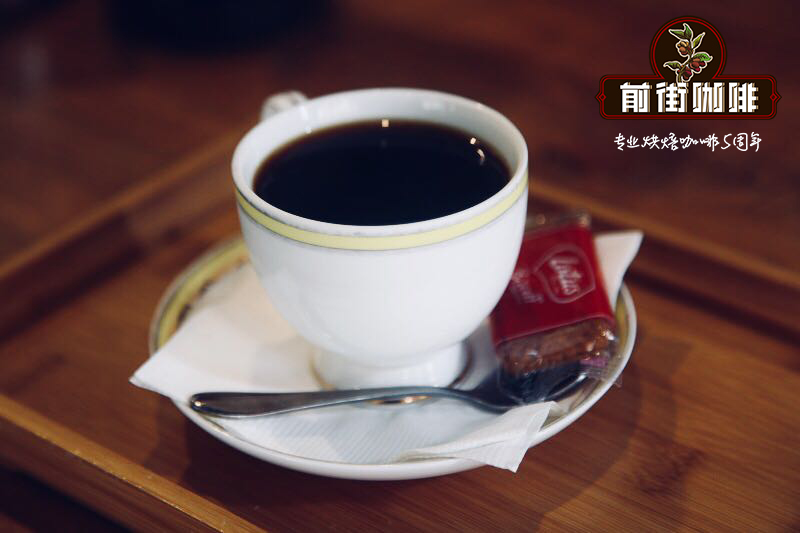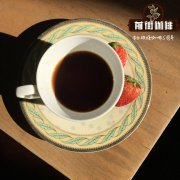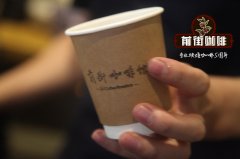The gouache ratio of hand-brewed coffee is better than that of using parameters.

Professional coffee knowledge exchange more coffee bean information please follow the coffee workshop (Wechat official account cafe_style)
[introduction] it is believed that most hand-brewed coffee lovers will pay attention to every detail of hand-brewing coffee. What should be the ratio of water to powder in hand-brewed coffee? Some say 1:16, some say 1:18, some say 1:10, let's know the different taste parameters of different gouache. Some beginners will ask, "if the gouache ratio of a serving of coffee powder is 15 grams and the gouache ratio is 1:15, multiplied by a factor of 15, you know how many grams of water you need, and you need 225g of water."
Practical parameters of gouache ratio of hand-brewed coffee
[heavy flavour] 1VOG 10ml Coffee Bean weight 1ml Coffee Coffee 13.5 (Bean weight ratio unboiled Water ml)
[moderate taste] 1-12-12-1-13 (I. e. 1-14. 5-1-15. 5)
[refreshing] 1-14-1-1-1-16 (I. e., 1-14-1-1-18. 5 of the Golden Cup Criterion)
The scale is right, but the brewing proportion is not right, and it is not easy to make delicious coffee. In the process of learning, we need to drink repeatedly and test the concentration. It is found that the best brewing ratio, that is, the amount of coffee beans is higher than that of black coffee, which is between 1 cup, 12 grams and 13 milliliters, which is equivalent to the four major gold cup systems in Europe and the United States. the yield of coffee beans is 14.5 grams 115.5 per gram of raw water, and it is most likely to hit the golden range of 18% 22% and 1.15% 1.35% of the "golden cup moment". Instead of brewing espresso with tangled flavor spectrum or thin coffee with too strong water flavor.
It is believed that the brewing ratio of most hand-brewed coffee lovers should fall within this range. Our most commonly used hand-brewing ratio is 1-15-15-1-16, that is, the "golden cup" criterion of 1-15-1-1-1-18. 5.
Of course, some lovers of hand-brewed coffee use a more extreme brewing ratio. For example, those who like heavy flavors often brew by hand at 1:10 (that is, the proportion of golden cup is 1-12.5), using a higher concentration to make up for the deficiency of extraction, that is, only to extract sweet flavors of sour hand-brewed coffee with low molecular weight and medium molecular weight, so as to avoid the extraction of high molecular weight bitter substances. Although you can also make delicious coffee with mellow flavor, the concentration is too high. It is not easy for ordinary people to accept, and it is too wasteful of coffee powder to be encouraged. In fact, a better coffee can be made at a more normal 1:12 (that is, a golden cup ratio of 114.5%).
Interestingly, there are also some light coffee lovers who like to brew by hand in a diluted proportion below 1:14, but do not underestimate these coffee lovers, whose taste buds may be sharper and can be appreciated in a variety of layers from the thinner coffee liquid. If you have to use 1:10 to brew in order to feel good enough, it may be that the taste is too dull and depends on high concentrations to stimulate it.
Let's take a look at this picture. There are two new slashes in the picture. The upper slash has more powder than the middle one, while the lower one has less powder than the middle one. You can see that when three different amounts of powder reach the same extraction rate (the same feeling of bitterness and bitterness), the cup with more powder will have a stronger taste, and vice versa.
The proportion of soaking will not decrease with the increase of the number of cups.
Many coffee lovers are good at making coffee for one person, but they will be at a loss if they increase the number of people. Some people say that one more person will multiply by two, and some will use 2 grams less powder for each additional person. That is to say, if one person brews a cup of 180 ml coffee with 14 grams of powder, once it is increased to two, only 26 grams of powder (saving 2 grams of powder) can be brewed twice as much, a total of 360 milliliters of coffee. The extractable water-soluble ingredients of coffee beans account for at most 30% of the bean weight, and coffee from some producing areas may be even lower. Taste buds can talk, and the proportion of 1RU 13.8 without 2 grams of coffee powder is obviously thinner than that of 1RU 12.8. After ExtractMoJo test, the concentration of 1Rd 12.8 is 1.42%, which is significantly higher than 1.39% of 1RU 13.8.
Therefore, under the same brewing ratio, the concentration of coffee will not increase naturally with the increase of the number of cups, that is to say, at 1:12, the concentration of one cup by hand is the same as that of two cups or three cups by hand in the same period. The amount of coffee powder will not increase because of the increase in the number of cups, and there is room to reduce the amount of coffee powder. The concentration of coffee powder can be determined by itself, unless you brew it with finer coffee powder or higher water temperature, which is another matter.
The measuring cup is necessary to catch the amount of extraction.
It is worth noting that the habit of hand flushing in Taiwan is different from that in Japan, where one cup or one person share is about 120ml or 130ml, but Taiwan feels too stingy. The average store will soak 150ml ~ 180ml, and coffee players are more magnificent. One person will probably reach two cups of 240 ml ~ 260 ml.
In other words, the milliliters of hand brewing in Taiwan are random, and it doesn't matter if you drink coffee romantically, it's not a bad thing. The point is that before hand flushing, it is best to test your bottom cup with a measuring cup. The amount of milliliters of your bottom cup is 120 ml or 130 ml. If three cups are used, the difference between the two is up to 30 ml, which is enough to affect the concentration.
In addition, although the bottom pot is easy to use, but the base is too large, coupled with the glass material is easy to lose temperature, ceramic insulation is better!
SCAA American boutique coffee association coffee brewing gold gouache ratio
The GoldCup coffee ratio defined by the SCAA American boutique coffee association and the scae European boutique coffee association must hold the extraction rate of coffee at about 20%, while the TDS is about 1.1% to 1.3%. For DripFilter (drip brewing), how to extract the best coffee flavor is controlled by two variables: the extract of coffee powder and the concentration in a cup of coffee. As early as 1960, the so-called golden cup caffeine defined GoldCupStandard according to SCAE (European Coffee Association): "1000ml water, 50g 60g coffee powder, 92 °C ~ 96 °C hot water to brew coffee." The coffee is brewed at the "bull's-eye" position of the optimum extraction rate (Extraction) and concentration (StrengthConcentration), that is, "GoldCup".
First of all, each coffee can be extracted, with a maximum of about 30% (that is, 70% of xylem cannot be extracted, that is, 10 g coffee powder has up to 3 g coffee extract.
Suggestions for practical parameters of brewing ratio:
Hand flush ratio 1: 13: 1: 16, siphon: 1: 12: 1: 13: 13, Philharmonic: 1:17
Wash Yega Chuefei by hand with a cup of water, this is a moderately shallow baked Yega Chuefeiwoca, it is recommended to use 15 grams of powder 89 degrees water temperature, water powder ratio at 1:15, the extracted taste is sour, with a little lemon peel, kumquat sweetness, rich in the latter section.
Hand-made Colombian Emerald Manor Sun Rose Summer Cup, this is a lightly baked rose summer, recommended 18 grams of powder, 88 ~ 89 degrees water temperature, gouache ratio at 1:15, small Fuji grinding degree 3.5. In this way, it has a moderate taste of sun fermentation, high sweetness and soft sour taste.
Hand-made Honduras cup, this is a medium-deep baked bean, recommended 15g powder, 90 degrees water temperature, water powder ratio at 1:14, small Fuji grind degree 4.5, overall taste balanced, with roasted nuts, milk chocolate flavor.
Siphon pot boil 90 + candlestick (light baking), side roast extraction, it is recommended that 20 grams of powder 2 portions, water powder ratio 1:12, water scale 2, after bubbling in the pot extraction for about 50 seconds, the extracted coffee taste clean and bright, the sun is full of sweetness, layers are changeable, flower and fruit fragrance lasting.
Philharmonic pressure Panama Flower Butterfly (medium roasting), positive pressure preparation, it is recommended to add 20g coffee powder, gouache ratio at 1:17, first add 100g hot water at 85 degrees Celsius, stir three to five times to make coffee powder fully wet, rest for 20s, add remaining hot water to 240g, rest for 40s, stir for 5s, wait until 1 minute 50 seconds, press up and down, total time is 2 minutes 5 seconds, ferment ripe fruit mellow, mild and clean balance, lasting caramel sweetness in tail rhyme.
Brew hanging-ear coffee, prepare a pot of boiling water (the water temperature for brewing coffee is recommended between 85 ℃-95 ℃), 10 grams of powdered coffee, the ratio of water to powder at 1:14-1:15, water with 150ml, pour hot water evenly into the filter bag when pouring boiling water (be careful not to be too fast and the water flow is not too large to avoid overflow). After the amount of liquid in the filter bag decreases, pour it again. When the coffee liquid in the cup reaches 7 cents full, it may be decided according to your taste. Carefully remove and discard the earbag.
How to correct it?
Suppose we soak in 10g coffee powder for 2 minutes to brew 150cc coffee, the distribution of the sweet and sour coffee is very satisfactory, but the taste is a little light, then how to adjust it?
As can be seen from the above picture, we must increase the amount of powder and maintain the same extraction rate. But the interesting thing is that if we soak the 150cc coffee for 2 minutes with 12g coffee powder, you will find that the distribution of sweet and sour coffee is not the same as that of the previous cup of coffee, but slightly more sour and sweet. In other words, when we increase the amount of powder, if the other extraction conditions remain the same, then the extraction rate will be reduced, as shown by the dotted line in the picture.
On the contrary, when the amount of powder decreases, if the other extraction conditions remain the same, then the extraction rate will increase. In other words, when the amount of powder changes, you must also think about whether other parameters of cooking need to be adjusted! In the case of just now, I may soak 12g powder for two and a half minutes to achieve a similar distribution of sweet and sour!
When you know this, congratulations, you have grasped the focus of the golden cup theory, although there are many factors that affect the taste of coffee are not included in this theory, but no matter what kind of brewing equipment, you can try to think with the logic of the golden cup theory.
Related recommendation: is hand-made coffee really good? Why does coffee smell better than it tastes?
Important Notice :
前街咖啡 FrontStreet Coffee has moved to new addredd:
FrontStreet Coffee Address: 315,Donghua East Road,GuangZhou
Tel:020 38364473
- Prev

What is the basic knowledge of hand-brewed coffee three-stage water injection step diagram
Many friends bought coffee beans from Qianjie to brew by themselves, and asked how to brew coffee by hand in the backstage. Therefore, Qianjie will simply share with you how beginners should get started to make coffee. Let's take a look at the video. The first video is the tapered filter cup in the getting started Reading of Top baristas to beginners.
- Next

How to brew authentic Blue Mountain Coffee in Daquan
Professional coffee knowledge exchange more coffee bean information please follow the coffee workshop (Wechat official account cafe_style) [preface] I believe you will soon receive [Jamaica Blue Mountain] beans, this time our Blue Mountain is from Clifton Manor, just on Clifton Hill, is still the oldest coffee producer in Jamaica, and there is only Clifton in Jamaica.
Related
- Beginners will see the "Coffee pull flower" guide!
- What is the difference between ice blog purified milk and ordinary milk coffee?
- Why is the Philippines the largest producer of crops in Liberia?
- For coffee extraction, should the fine powder be retained?
- How does extracted espresso fill pressed powder? How much strength does it take to press the powder?
- How to make jasmine cold extract coffee? Is the jasmine + latte good?
- Will this little toy really make the coffee taste better? How does Lily Drip affect coffee extraction?
- Will the action of slapping the filter cup also affect coffee extraction?
- What's the difference between powder-to-water ratio and powder-to-liquid ratio?
- What is the Ethiopian local species? What does it have to do with Heirloom native species?

